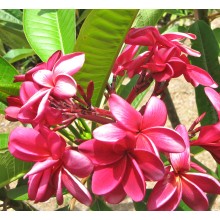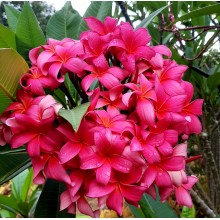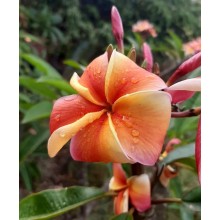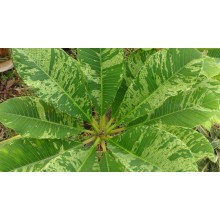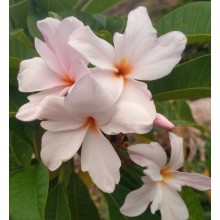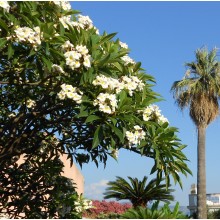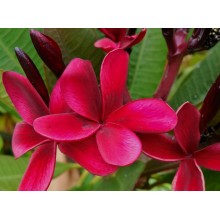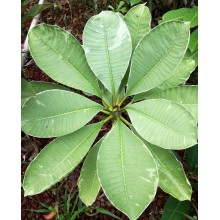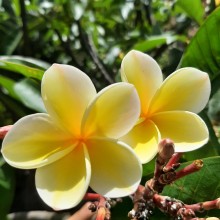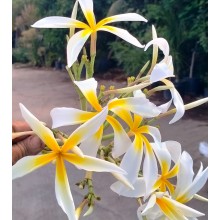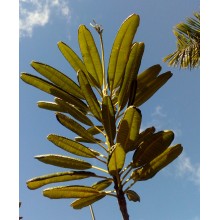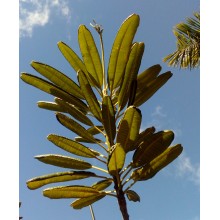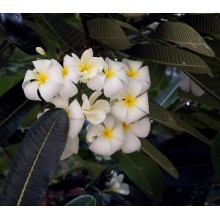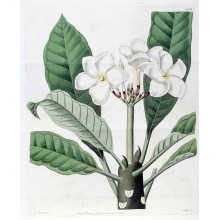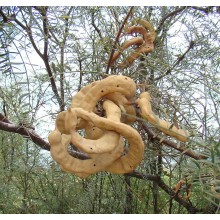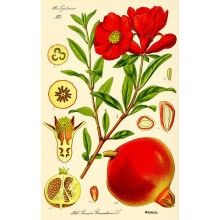Plantas Resistentes a la sequía Hay 140 productos.

En esta sección agrupamos aquellas plantas que se adaptan a las condiciones áridas o de sequía. Normalmente, la mayoría de estas especies, que se cultivan en condiciones áridas, tienen hojas cerosas, suculentas, peludas, pegajosas, tipo agujas, o incluso, más pequeñas que el resto.
En Plantas resistentes a la sequía se puede encontrar cualquier especie con estas características: Pithecellobium dulce, Ruta graveolens, Syzygium cordatum, Tamarindus indica y así sucesivamente.
-
Plumeria 'Irma Bryan'
Plumeria 'Irma Bryan'
Adult, thick 40-80 cm plant. Early season Pink-Red flowers with great spicy fragrance. These flowers last a lot of days if kept floating in water! The tree is quite robust and umbrella-shaped.
45,00 € -
Plumeria 'Japanese Lantern'
Plumeria 'Japanese Lantern'
Almost everblooming! From Spring to Christmas. - Old, classic, great Plumeria cultivar with bight pink drooping flower heads. The plant is very easy to grow and quite upright, thin at first but very robust eventually, becoming a long lived tree. We offer an adult, thick 25-50 cm plant.
26,60 € 38,00 €¡Precio rebajado! -
Plumeria 'Mont Blanc'
Plumeria 'Mont Blanc'
Mont Blanc is very different from the usual Plumeria rubra hybrids. Bushy, wiht white-pink ruffled frilly petals, which are very uncommon in plumerias. It is something new in many aspects.
84,00 € -
Plumeria 'Palermitana'
Plumeria 'Palermitana'
This is one of the cold hardiest of all Plumerias. It bears perfect domes of white and yellow flowers with overlapping petals.This cultivar is known from the Italian city of Palermo, in Sicily. It is well adapted to the mediterranean climate and takes more cold than most other cultivars. Experts suspect that it could be a hybrid ...
37,20 € -
Plumeria 'Parameno'
Plumeria 'Parameno'
Parameno (Also spelled Paramino, Palameno or Palamino) is a Thai cultivar with thick, yellow-orange flowers and dark green leaves and stems. It is semi-compact in growth.
42,20 € -
Plumeria 'Scott Pratt'
Plumeria 'Scott Pratt'
Scott Pratt is a dark red flowered Plumeria from Hawaii. For years it was called the "Black Plumeria", as its flowers are so dark-red-purple that they often look almost black. It has rather thin upright stems. Leaf midribs are tipically dark too.
31,40 € -
Plumeria 'Silver leaf'
Plumeria 'Silver leaf'
Plumeria'Silver Leaf' is for us one of the most different and most attractive variegated plumerias. It has a delicate milky bloom all over the leaf and a cream-white margin that often becomes larger with white speckles. Flowers are pink and white with a yellow throat.
68,00 € -
Plumeria 'Son of Celadine'
Plumeria 'Son of Celadine'
Also known as Hawaiian Yellow Plumeria and Graveyard Plumeria. This cultivar has large flowers with a big yellow center that fades to a creamy white at the tips.
38,00 € -
Plumeria 'Stella di Davide'
Plumeria 'Stella di Davide'
Old cultivar from Sicily with a truly different white-and-yellow flower, with very slender petals and strong scent. The bark is silvery, somehow like Plumeria 'Palermitana'. Nobody knows if it is a Sicilian selection or if it was brought from somewhere else at least one century ago.
54,00 € -
Plumeria 'TPP'
Plumeria 'TPP'
TPP is a friendly version of its rather lengthy Thai name, which is spelled in many ways: Thippatumporn, Thippatumporn, Thiphathumton, Tippratumporn, Tippratummaporn. Its flowers have thick petals with can be pink, orange or white depending on temperature/season, but they always show an unmistakeable brown tone. It is a good bloomer, with dense...
48,70 € -
Plumeria obtusa 'emarginata'
Plumeria obtusa 'emarginata'
This plumeria endemic to karstic areas in Northern Cuba has narrow leaves with very revolute margins.
40,00 € -
Plumeria obtusa 'emarginata' LARGE
Plumeria obtusa 'emarginata' LARGE
This plumeria endemic to karstic areas in Northern Cuba has narrow leaves with very revolute margins. 80cm tall specimen.
76,90 € -
Plumeria obtusa 'Singapore'
Plumeria obtusa 'Singapore'
One of the most beautiful of all plumerias. The true wild Plumeria obtusa from Cuba is less ornamental than this one.
25,20 € -
Plumeria rubra - Wild Type
Plumeria rubra - Wild Type
This is a wild form of Plumeria rubra, not a hybrid or a selection as ALL the ones you will find in the trade. Wild types are tough guys from the coastal scrubs of Central America, able to withstand truly harsh conditions. It is very vigorous with large leaves. Flowers are white with a yellow center.
42,00 € -
Prosopis chilensis 'Large Fruited' – Chilean Carob Tree
Prosopis chilensis 'Large Fruited' – Chilean Carob Tree
Small tree from arid areas in N. Chile, S. Peru and N. Argentina, with feathery "Mimosa leaves". The beans are used in a way similar to carobs, to make a sweet flour that can be added to desserts, pastries, soups and even ice-cream. Just like for carobs, the dried pods can be eaten raw as a snack.
46,20 € -
Punica granatum 'Dente di cavallo'
Punica granatum 'Dente di cavallo'
Dente di Cavallo is a traditional Italian variety of cold-hardy pomegranate. Fruits ripen at the end of September. They are medium-large, with a green skin tinged with red. Inside it is ruby red, sweet and delicate in flavour. The seeds are hard, woody inside, reminiscent of horse teeth (that means "dente di cavallo") due to their trapezoidal shape.
56,20 €
En estos momentos tenemos pocos productos en esta categoría Plantas Resistentes a la sequía

















